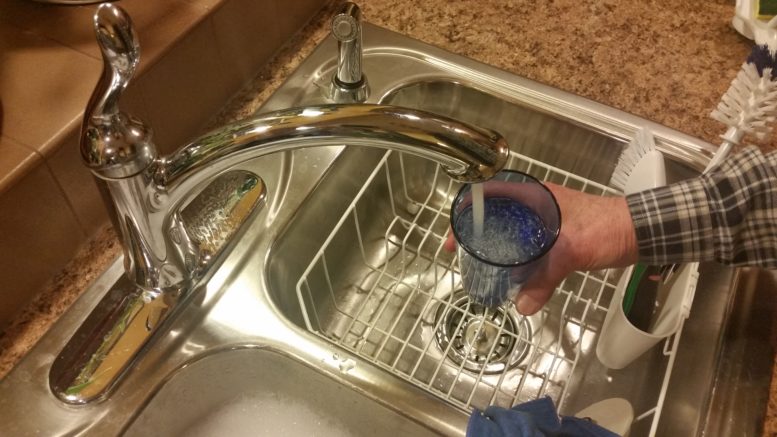By JAN LARSON McLAUGHLIN
BG Independent News
With the help of $1 million in American Rescue Plan Act funds, households throughout Wood County will soon have the water lines into their homes checked for lead.
Using the COVID relief funds, the Northwestern Water and Sewer District is working to identify lead water lines that linger in Wood County.
Last year, the Wood County Commissioners Office sent a letter out to communities that have their own water systems, offering a chance to have their water lines checked for lead piping.
“The Wood County Commissioners are aware of the health concerns that are associated with public water service provided through lead service lines,” the letter stated. The health risks of lead in water can be significant and long-lasting, especially to young children.
The U.S. EPA has mandated all municipal water treatment providers to evaluate their distribution and delivery systems to ensure that any lead lines be identified by October of 2024.
“Those entities with aging systems may find this to be a difficult and costly task,” the commissioners’ letter stated.
So the commissioners offered $1 million to implement a countywide lead service identification program – and the Northwestern Water and Sewer District accepted the challenge.
The program will use a qualified contractor to expose the unidentified service lines through a low impact, vacuum excavation process and to log the information for all the systems.
“This is a countywide program to help us all identify the lead service lines,” said Tom Stalter, manager of engineering for the NWWSD. If lead lines are found, Stalter said a replacement program may be created, with public-private cost sharing.
Some communities have already identified the material used in the lines leading into homes. For those still unknown, the NWWSD program will use the excavation process, which creates a 8-12-inch hole down to the service line.
“It’s a minimally invasive process,” Stalter said, with most lines being checked near the sidewalks, close to the property right-of-way lines.
Property owners will be notified at least 24 hours in advance of the work, said Theresa Pollick, public information officer for the district. The work generally takes one hour or less, there is no interruption to water service, and yards are repaired following the vacuum excavation.
Eight communities in Wood County operate their own water systems, and have been invited to join in this program. They are Bowling Green, Bradner, Fostoria, North Baltimore, Pemberville, Perrysburg, Tontogany and Wayne.
Like all communities in Ohio, Bowling Green is under orders to make sure its water isn’t flowing through lead lines on the way to its customers’ faucets.
The city has been working on its water service line inventories for a couple years now. Though the newer service water lines are identified in detail, some of the “old-timers” hinted at the location of lines with descriptions like “east of the oak tree,” Bowling Green Public Utilities Director Brian O’Connell said.
Since 1986, lead has been banned for use in water lines, and in the 1990s any known lead service lines in Bowling Green were replaced.
O’Connell explained last year that the city is responsible for the portion of the waterline that extends to the curb stop, but the portion of the line going into a residence is the homeowner’s responsibility.
So while O’Connell is confident the lead lines in the city’s portion have been replaced, the same cannot be said of the portions that are the responsibility of homeowners.
Homes built before 1986 may have lead plumbing fixtures, since prior to then Ohio plumbing code allowed lead in fixtures.
There is no lead present in the drinking water as it leaves the city’s water treatment plant, O’Connell said. The city treats the water to reduce the potential for lead to contaminate the drinking water. This is achieved through a corrosion control treatment process and by adding orthophosphate to the water as a corrosion inhibitor.
Stalter also assured that water from NWWSD lines undergoes regular testing.
“Our system is safe,” he said. “We’re confident that it’s safe,” but the inspections must be done to meet EPA regulations.
The NWWSD has kept Bowling Green officials involved in discussions about the opportunity to take advantage of the ARPA funds to help identify lead service lines, said Jim Odneal, assistant director of city utilities.
There are two parts of water lines to be identified and mapped – the utility side and the customer side. The district is excavating each side of customers’ curb boxes to identify the materials of the water lines.
Bowling Green is in a different position, Odneal said.
First, Bowling Green has already identified all of the service lines on the utility side, and there are no lead lines in the city system, he said.
And second, to identify the materials on the customer side, the city has decided to enter the homes and look at the materials at the water meter. It was decided this would be less invasive and less expensive than excavating, Odneal said.
The city has received a $50,000 EPA grant to help with the waterline material inspections.
“That being said, we may have as many as 5,000 homes to investigate and will quickly exceed the EPA grant amount in expenses,” Odneal said. “The district has expressed interest in sharing a portion of the ARPA funds to contribute towards our efforts in Bowling Green. We have yet to negotiate what that amount will be.”
Following is a video of the Northwestern Water and Sewer District waterline material mapping program piloted in McComb:
Bowling Green plans to initiate press releases as officials work through particular neighborhoods in town as part of an effort to notify residents. More information can be found in the “Community Spotlight” section of the city website: https://www.bgohio.org/196/Utilities , and additional information can be found here: https://www.bgohio.org/642/Lead-Water-Service-Line-Information




